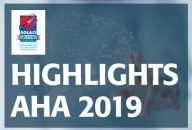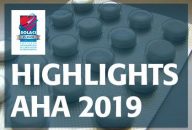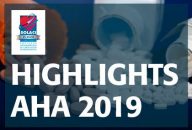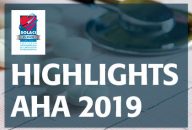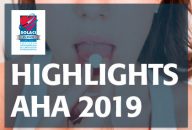This analysis shows that the long-term clinical benefit of left atrial appendage closure with Watchman is superior to warfarin in patients with atrial fibrillation (AF). The initial peri-procedural risks of device implantation are counterbalanced over time, with reduced risk of bleeding and death. The PROTECT-AF (Watchman Left Atrial Appendage Closure Technology for Embolic Protection in…
AHA 2019 | Treat Stroke to Target: Post-Stroke Aggressive Therapy with Statins
Indicating statins to reach more aggressive LDL goals in patients that have suffered transient ischemic attack or ischemic stroke driven by atherosclerosis significantly reduces major cardiovascular events according to this study presented in the AHA 2019 scientific sessions simultaneously published in NEJM. The study was prematurely ended because of lack of funding, but its outcomes…
AHA 2019 | GALILEO: Rivaroxaban After TAVI, Another Nice Theory that Clashes with Reality
In patients without formal indication for oral anticoagulation after successful transcatheter aortic valve implantation (TAVI), a treatment strategy including rivaroxaban 10 mg daily was associated with a higher risk of death or thromboembolic complications and, on top of that, a higher risk of bleeding than a conventional antiplatelet strategy. So far, we did not know whether…
AHA 2019 | DAPA-HF: Dapagliflozin Effective for all Heart Failure Subgroups
SGLT2 inhibitor dapagliflozin had a consistent impact regardless of glycemic level, age, or general health status. Dapagliflozin was originally developed for the treatment of type 2 diabetes. However, it has had a positive impact on various types of patients with chronic heart failure and reduced ejection fraction, including those without diabetes. This information is derived from…
AHA 2019 | COLCOT: Colchicine and the Return of the Anti-Inflammatory Theory
Low-dose colchicine seems to reduce the risk for new cardiovascular events in patients with a history of infarction. This drug is usually indicated for anti-inflammatory therapy in gout and pericarditis. Now, it could also reduce the rate of ischemic events as secondary prevention according to the COLCOT trial presented during the American Heart Association (AHA)…
AHA 2019 | TWILIGHT: Discontinue Aspirin after Acute Coronary Syndrome
This study findings confirm less bleeding at no extra cost of thrombotic events when aspirin is discontinued after an acute coronary syndrome (ACS). In the same line as the original TWILIGHT, this study focused on ACS patients alone (excluding STEMI) and confirmed that aspirin discontinuation after 3-month DAPT to continue with ticagrelor alone, reduced the…
AHA 2019 | GALILEO-4D: Rivaroxaban in the Prevention of Post TAVR Valve Thickening and Thrombosis
This sub study of the GALILEO specifically looked at valve thickening and reduced leaflet motion after TAVR documented with 4D CT. Whether anticoagulation with rivaroxaban might reduce or prevent this phenomenon remained unanswered. Patients receiving the same anticoagulation scheme than the general study’s (rivaroxaban + aspirin vs. aspirin + clopidogrel) were assessed by 4D CT…
Statins in Primary Prevention: As Questioned as Aspirin?
This new review, recently published in BMJ, questions the benefit of statins in low-risk primary prevention patients. Authors argue that statins should be more cautiously indicated in primary prevention, considering that their absolute benefit is almost marginal in low-risk patients. Changes in the European guidelines have translated into a wide expansion of patients eligible for…
What Is the Best Time to Take Antihypertensives?
Bedtime hypertensive therapy might reduce the risk of cardiovascular events according to this study soon to be published in Eur Heart J. However, despite showing significant risk reduction this hypothesis calls for further study before radically changing the usual upon awakening therapy. Taking the prescribed medication before bedtime could allow our bodies to naturally follow…
Major Bleeding in Patients with Aspirin Plus Rivaroxaban
The combination of coronary artery disease or peripheral vascular disease and a reason for anticoagulation, such as atrial fibrillation, results in many patients who receive antiplatelet therapy with aspirin plus anticoagulation with rivaroxaban, for example. It is a well-known fact that this combination (aspirin 100 mg per day plus rivaroxaban 2.5 mg twice per day) reduces cardiovascular…
Major Bleeding in Patients with Aspirin Plus Rivaroxaban
The combination of coronary artery disease or peripheral vascular disease and a reason for anticoagulation, such as atrial fibrillation, results in many patients who receive antiplatelet therapy with aspirin plus anticoagulation with rivaroxaban, for example. It is a well-known fact that this combination (aspirin 100 mg per day plus rivaroxaban 2.5 mg twice per day) reduces cardiovascular…

